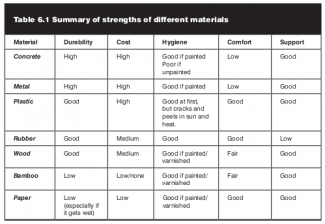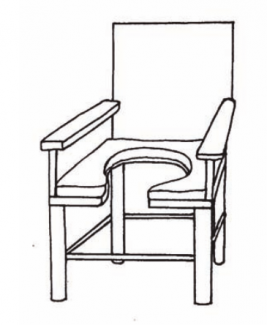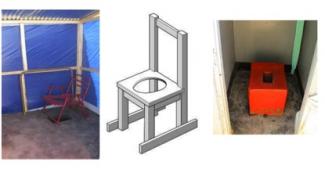Seat
Making a seat, for example for hygiene purposes, or for adapting a latrine in order to address specific needs of persons with disabilities is relatively easy to do with local material.
For all adaptations though, one general rule to remember is to make sure the seat and the wheelchair / bed are at the same level. An individualized approach is therefore essential. Seats should be designed to enable a person with difficulties standing or transferring from / to a seat or a wheelchair to conduct their hygienic needs in a dignified and safe manner.
Seat could be made from a variety of materials, depending on int intented use (for sitting, washing ora commode seat): a cement-plastered seat, wooden made seat, or adaptation of plastic seat / chair. Using ceramic is also a possibility.
Seven materials that can be found in most countries (concrete, metal, plastic, rubber, wood, bamboo and paper) are hereafter reviewed through 5 criteria (durability, cost, hygiene, comfort and support).
Concrete and metal:
- durability is high
- cost is high
- hygiene is good if painted, poor if not
- comfort is low
- support is good
Plastic:
- durability is good
- cost is high
- hygiene is good at first, but cracks and peels in sun and heat
- comfort is good
- support is good
Rubber:
- durability is good
- cost is medium
- hygiene is good
- comfort is good
- support is low
Wood:
- durability is good
- cost is medium
- hygiene is good if painted, or varnished
- comfort is fair
- support is good
Bamboo:
- durability is low
- cost is low / none
- hygiene is good if painted, varnished
- comfort is fair
- support is good
Paper:
- durability is low, especially if it gets wet
- cost is low
- hygiene is good if painted, varnished
- comfort is good
- support is good
Of course, these elements need to be reassessed to the specific context in each country, but it gives a baseline and orientation for deciding on type of material.

Here are a few tips to use when building or adapting different seats or chairs.
For bathing seat:
- A chair or seat is important for persons that cannot stand without support, or for longer periods, to ensure they can clean themselves in a dignified and hygienic manner;
- The seat or chair can be fixed on the floor of the washroom or for example on the concrete platform of a well;
- Its weight needs to be suitable for transferring easily as mentioned above. User should be consulted and involved during shaping. A low seat makes it easy for working on the floor, but may make independent transfer to a wheelchair or bed difficult;
- Side-rails should be made movable for the person to hold onto for balance while transferring or bathing.
For movable commode seat:
- Locally made at a reasonable cost, it will provide autonomy and comfort to persons with disabilities when, for any reason, they can not reach outdoor latrine or washrooms;
- The seat can be made from a plastic chair, or made from wood, and has a hole with a pot or container underneath;
- If made of wood, it is important to paint or varnish it: it will make it easy to clean and help water drainage (avoiding the wood rotting);
- When being locally shaped and built, plan for a gap in the seat: it will allow access for anal cleansing from the front (but note that edges should be sanded, or curved, to make them comfortable for users).


For toilet seat
- A pedestal classic toilet seat can be adapted with a painted wooden frame, in case it is not it is not possible to fix handrail on walls;
- A squat toilet can also be adapted by placing a handrail in front, or placing a plastic or wooden chair on top of the pit;
The height of toilet seat should allow the user to :
- easily sit down and stand up;
- comfortably rest both feet flat on the floor while seated on it.
The ideal toilet height will depend on how tall is the user, his/her physical needs, and the manner in which he/she transfer on and off the toilet. Get in touch with the local organisation of persons with disabilities in order to know if national height standards exist.

While planning and designing washroom or latrine, it is important to leave sufficient free area next to the toilet seat for a wheelchair user to be able to transfer him/herself from the wheelchair to the seat. If possible, a free circle of 150 cm should be provided so that the person can make a complete turn. The presence of grab bars will help the user to get on and off the toilet seat.
